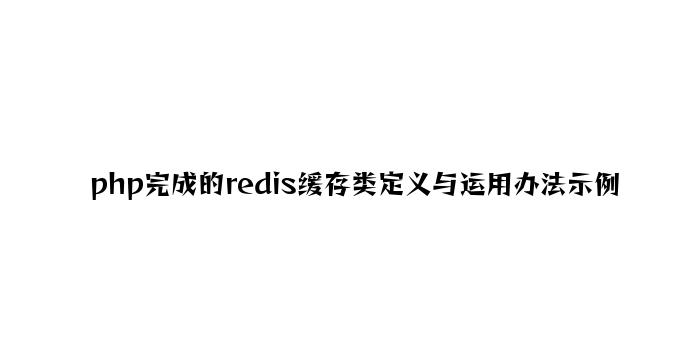
本文实例讲述了php实现的redis缓存类定义与使用方法。分享给大家供大家参考,具体如下:
php+redis缓存类
<?php
class redisCache {
/**
* $host : redis服务器ip
* $port : redis服务器端口
* $lifetime : 缓存文件有效期,单位为秒
* $cacheid : 缓存文件路径,包含文件名
*/
private $host;
private $port;
private $lifetime;
private $cacheid;
private $data;
public $redis;
/**
* 析构函数,检查缓存目录是否有效,默认赋值
*/
function __construct($lifetime=1800) {
//配置
$this->host = "127.0.0.1";
$this->port = "6379";
$redis = new Redis();
$redis->pconnect($this->host,$this->port);
$this->redis=$redis;
$this->cacheid = $this->getcacheid();
$this->lifetime = $lifetime;
$this->data=$redis->hMGet($this->cacheid, array('content','creattime'));
//print_r($this->redis);
//print_r($this->data);
}
/**
* 检查缓存是否有效
*/
private function isvalid(){
$data=$this->data;
if (!$data['content']) return false;
if (time() - $data['creattime'] > $this->lifetime) return false;
return true;
}
/**
* 写入缓存
* $mode == 0 , 以浏览器缓存的方式取得页面内容
*/
public function write($mode=0,$content='') {
switch ($mode) {
case 0:
$content = ob_get_contents();
break;
default:
break;
}
ob_end_flush();
try {
$this->redis->hMset($this->cacheid, array('content'=>$content,'creattime'=>time()));
$this->redis->expireAt($this->cacheid, time() + $this->lifetime);
}
catch (Exception $e) {
$this->error('写入缓存失败!');
}
}
/**
* 加载缓存
* exit() 载入缓存后终止原页面程序的执行,缓存无效则运行原页面程序生成缓存
* ob_start() 开启浏览器缓存用于在页面结尾处取得页面内容
*/
public function load() {
if ($this->isvalid()) {
echo $this->data['content'];
exit();
}
else {
ob_start();
}
}
/**
* 清除缓存
*/
public function clean() {
try {
$this->redis->hDel($this->cacheid, array('content','creattime'));
}
catch (Exception $e) {
$this->error('清除缓存失败!');
}
}
/**
* 取得缓存文件路径
*/
private function getcacheid() {
return $this->dir.md5($this->geturl()).$this->ext;
}
/**
* 取得当前页面完整url
*/
private function geturl() {
$url = '';
if (isset($_SERVER['REQUEST_URI'])) {
$url = $_SERVER['REQUEST_URI'];
}
else {
$url = $_SERVER['Php_SELF'];
$url .= empty($_SERVER['QUERY_STRING'])?'':'?'.$_SERVER['QUERY_STRING'];
}
return $url;
}
/**
* 输出错误信息
*/
private function error($str) {
echo '<div style="color:red;">'.$str.'</div>';
}
}
//用法:
// require_once('redisCache.php');
// $cache = new redisCache(10); //设置缓存生存期
// if ($_GET['clearCache']) $cache->clean();
// else $cache->load(); //装载缓存,缓存有效则不执行以下页面代码
// //页面代码开始
// //页面代码结束
// $cache->write(); //首次运行或缓存过期,生成缓存
?>
更多关于PHP相关内容感兴趣的读者可查看本站专题:《php+redis数据库程序设计技巧总结》、《php面向对象程序设计入门教程》、《PHP基本语法入门教程》、《PHP数组(Array)操作技巧大全》、《php字符串(string)用法总结》、《php+mysql数据库操作入门教程》及《php常见数据库操作技巧汇总》
希望本文所述对大家PHP程序设计有所帮助。
-----正文到此结束-----



![php学习笔记 面向对象中[接口]与[多态性]的应用](/upload/20240207/202402070130021533.jpg)


发表评论 取消回复